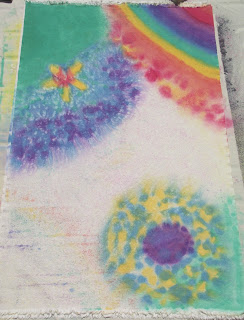Raw canvas was on sale at my local art store recently for $0.75/foot. I was able to get two 3'x5' piece for only $7.50!! Wow. I've always wanted to paint on a larger size of canvas but was daunted by the price of big stretched canvases.
Raw or 'unprimed' canvas hasn't been painted/primed with gesso so it will soak up paint like mad. This makes it not as inexpensive as it may seem because you will spend a lot in paint when you use it.
I did some experimenting to find ways around this and am sharing the results, so far, with you here. This is an incomplete work in progress. I intend to leave this unstretched and use it as a wall-hanging when complete.
1. I washed the canvas in hot water with laundry soap and baking soda. I didn't wash anything else with these because I didn't want them to get bunched up and crease badly. I did not to use fabric softener.
2. Cut away shredded bits that had frayed at the cut ends. Then I dried the canvas in the dryer (once again NO fabric softener - it can prevent paint from adhering).
3. Removed from dryer right away and ironed. This would have been hard on an ironing board so I used the kitchen table. Because I had 2 pieces of canvas, I doubled them over so there were 4 layers of canvas between the table and ironing board at once, then flipped, rotated as needed to iron all of the canvas. I used a spray bottle to dampen the canvas and high heat.
What I was left with: the washing, drying and ironing shrank the canvas a bit and made the weave tighter. Exactly what I was hoping for.
My plan was to use watered down super cheap paint to cover the canvas so that I could paint on it later with less cheap paint. However, I think I am liking the look of this so much, that it will become the actual painting - not just a background. I used the Michael's store brand 2oz bottles that cost $0.69/bottle. I've covered tons of the canvas so far and used less than 5 bottles! Assuming I use 6 by the time I am done that will be $4 of paint. Far more affordable than gessoing the canvas.
I planned to make a big mess so I took this project out onto the deck with an old sheet under it (and books to weigh down corners due to wind).

I did some weeding:
detail of weeds which will serve as a 'resist', leaving areas unpainted under them:
Acrylic paint mixed with water (a bit more than half water) and sprayed using the Tulip Fabric Paint Cannon:
Spraying a layer of pink:
Adding a few objects and then spraying yellow:
Spraying white, then removing all objects:
detail of weed resist area:
By this time I had a blister on the finger that had been spraying so I put away the sprayer. I put paint and water into empty paint bottles and shook them up to make very watery paint (about half and half paint:water).I waited for the top layer to dry - very fast since it was a sweltering hot, sunny day.
Then I flipped the canvas over and and began applying the paint to the back with a big brush, adding water as needed with the brush. This side looks very primary but I will paint over it later and this canvas will become double-sided - I can rotate it on a whim :)
I chose where I put the big washes of colour on the back because I wanted it to bleed through in specific places on the front. For example I wanted the weeds to be greenish.
With this technique, what happens is that the paint on the front blocks colour from bleeding through from the back. The paint from the back only will bleed through onto any remaining parts of canvas that are still raw. It ended up having a far cooler effect than I had expected and I'm really excited about it :-)
One of the parts of this piece that I love most is the way the colour gradation shows through in the three diagonal lines in the corner:
I put my second piece of canvas under the piece I was painting part way through - as soon as I saw what cool effects were bleeding through onto the old sheet. I wanted them on the blank canvas instead!
Would I do anything differently if I did this again?
Yes - first of all I would use more than one finger for holding down the spray nozzle! :-)
I also would leave more areas raw, with only sparse splatter on them, because of how much I love the bleeding through effect.


























